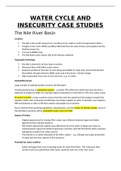Summary
Summary Water Cycle and Insecurity CASE STUDIES Edexcel A level Geography (Unit 3 - Physical Systems and Sustainability)
- Course
- Institution
- Book
A complete document of all the specification listed case studies required for enquiry questions 1, 2 and 3 of 'Water cycle and insecurity', Topic 5 of Unit 3 in A level Geography (Edexcel). Put together by an A* student. Includes the following case studies: The Nile China water transfer Singap...
[Show more]




